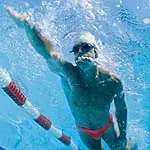
These methods teach swimmers to elongate their bodies by balancing, stretching, gliding and rolling. Balance is fundamental and should be maintained throughout the stroke. As the swimmer moves through the water each side of the body should mirror the other side respectively to achieve swimming symmetry.
However, as much as elongating and lengthening the body looks proficient, fluid and even feels good there's a cost. Fundamental techniques differentiate better swimmers from those who sink and struggle along lap after lap.
More than just drills and balance
Better swimming is not achieved only with drills. No stroke should be taken without the swimmer being kinesthetically in tune with technique. That is, a swimmer executing better technique should have a sense of body position, weight or movement of the muscles, tendons, and joints. Parenthetically, the same can be said for cycling and running as well.
To be sure, body balance is necessary for optimal swimming. Good swimmer's hips are high in the water thereby, reducing drag over the legs and gently slipping through the water. Surely, balance and other drills effectively teach kinesthetic awareness (movement sensitivity) but not hand, arm and shoulder mechanics and execution. Drills alone do not help triathletes who otherwise have flawed mechanics. And with improved core mechanics drills like balance training only then benefit the swimmer.
Six years and several hundred sessions of coaching triathletes in a swim flume have given me a unique research opportunity I didn't appreciate when I began. As a result I have evolved from coaching simply drills to coaching swimming competency. Drills do not educate and teach competencies. Only then can a swimmer know they are executing and demonstrating proficiency. And as a coach I have established fundamentals every swimmer must execute competently in order to advance.
Maintain constant momentum
The swimming flume sharpens a coach's eye. In addition the flume, with capability of underwater video and instant replay, has provided me with continuous observation of swimmers in action. Based on years of experience and the use of these assessment tools, I now place greater emphasis on a swimmer's competency in executing hand, arm and shoulder mechanics than merely on the mastery of drills.
I strongly differ with the glide and extension techniques commonly coached. Balance drills put the swimmer in a faulty body position. Chiefly, the elongation of the hand, arm and shoulder diminishes propulsion and constant momentum. To be sure, I've taught a full-extension for over 20 years having grown up with the catch up drill, one arm drills, sick kicks, streamlining and gliding, reaching and fully extending for as much distance per stroke.
I now coach swimmers to maintain constant momentum (continual churning and motion of the hands) by entering earlier, arcing forward and downwards and exiting the water at the hip. This is a better open-water stroke as well since resistance from a chaotic water environment necessitates constant propulsion. And according to research at USA swimming, "... positive hand forces stop before the hand reaches the hip ... and propulsive forces are negligible throughout the stroke ..." Such evidence validates an early catch and early exit along with equal body rotation (symmetry) and a straighter pull-through.
While Olympic gold medalist swimmers Grant Hackett and Ian Thorpe use what is called a catch up or front quadrant type of technique, I would argue each glides or extends forward only transiently. And in close analysis the catch for both is made after a short arc (forward and downward moving arc catching and gripping the water) as the pull begins. This technique ensures a continuum of momentum (the stroke does not stop and the body does not glide with no hand movement) as propulsion is constant. Noteworthy, are the respective high elbow, vertical forearm positions. These provide for increased pulling time and distance.
In reality, the longer the forward arm and hand are held out front along the surface of the water the less continuous forward motion is preserved. When the hand stops moving body momentum (forward movement) slowly glides and declines. The hand and arm should never at any time during the stroke stop moving.
Enter the water early, arc forward and down by rotating the shoulders to about 45 degrees symmetrically to either side. Do not let either shoulder drop too far down (do NOT rotate or extend forward as many drills teach). By holding the shoulders high (no more than a 45 degree sideways rotation) the swimmer is then able to easily enter early, catches the water soon thereafter thereby allowing the continuum of the stroke to be maintained. Side to side rotation of the shoulders reduces the extension of the arms and shoulders and in turn makes for an "early catch" which enables immediate propulsion.
A limit of body/shoulder rotation keeps the arm and elbow from dropping. The dropped elbow (elbow below the hand during the pull) generally is the most difficult position to correct in a swimmer. Too, it's helpful for the shoulder of the entering arm not extend too far forward; nor, will the same shoulder drop more than a few inches below the surface. The shoulders are best symmetrically rotated on a forty-five degree axis (side to side). In addition, a high elbow pull is likewise helped by position the forearm vertical following the catch.
A comparison can be made by imagining the hand grabbing onto the wrung of a ladder. In order to pull upwards the elbows must be high. They cannot go below the elbow without hitting the ladder. Also, a great dryland tip is to stand facing a wall placing the arms overhead with the tips of the fingers touching the wall. Now, slowly move the hands and fingers down to the hips. All the while the elbow will stay above the hand as it should when swimming.
By symmetrically (bilaterally) executing this technique the continuum of momentum is maintained. Further, imagine the hand and forearm slowly arcing forwards and downward until grabbing onto the wrung. At this time, the swimmer will pull straight backwards and exiting the water near the topmost of the hip. Yes, that's what I said ... the topmost of the hip. Most coaches and methods teach full extension of the hand to the thigh. However, this is incorrect as it results in a further glide and extension resulting in a loss of momentum. And this is a common problem to be aware of as well.
Practice the kayaking stroke
Again, looking closely at Olympic level swimmers you will note there is little stretching forwards. Rather, the hand catches or engages the water very soon and have been recently referred to as the "kayaking stroke". A comparison of a surfer paddling into the waves is useful. Each time the hand enters the water the surfer immediately "catches" the hand onto the water by "gripping" a strong hold and pulling and pressing backwards. And more importantly, the surfer does not pull too far backwards, but only to about the top to middle of the hip. If pushing to full extension the opposite hand would need to glide and in the waves and surf it is ultimately important to be in control and have constant momentum on the board.
No surfboard? Try the above with a kickboard. Push off the wall with one forearm diagonally across the board (holding onto the stroking arms side) at 90 degrees. This keeps the shoulder from extending too far forward. Take four strokes with the free arm then switch to the other arm. This simulates the correct early catch and early exit. Yes, this is a drill!
Similarly, swimming necessitates this momentum to be constant. And there is no better method in keeping forward pace constant than by engaging the water early, minimizing extension and gliding and exiting the hand early. By the top or middle of the hip is best.
There are many other aspects to the swimming stroke of course, but the arcing-non glide as fundamental should not be overlooked and under-trained. To be sure, the triathlete can improve significantly by combining this technique along with "balance" training to obtain the best of all possible outcomes for swimming.
I've come to learn balance and many drills are not the solution for improved swimming. Rather hand, arm, shoulder and timing mechanics are principally far more important. Balance and swimming related drills together with the techniques described here perhaps, are a better way to achieve more efficient swimming. And surely balance plays a part, an important one, but not the most important.
Swimming is a DRILL -- 14 points to remember
- Entry earlier with the middle or ring fingers in a continually moving forward and downward arc
- Catch the water by positioning the hand gently onto the water
- Never stop moving the hand during the stroke
- Keep the shoulder high in the water at the beginning of the pull
- Pull straight through with a high elbow (above the hand or forearm vertically pointing downwards)
- Exit the water at the hip (palms down and facing backwards)
- Recovery: Accelerate and speed this up a little
- Keep a "fixed forward shoulder-line" -- Don't extend forward at the entry -- Don't let the shoulder slope forward
- Rotate symmetrically side to side about 45 degrees
- Swim forward: Yes, obvious, but that's the idea "forward"
- Avoid unnecessary movement throughout the stroke
- Breathing: Move the hand during each breath and inhale at the beginning of the pull
- Bi-lateral breathe (take a breath every third stroke) during warm up and warm down
- Maintain proper head position. The same as standing with tall posture with the head and neck balanced
Marc Evans was the sport of triathlons first professional coach, beginning in 1982. He currently coaches individually triathletes from his offices in Menlo Park, CA and can be found at www.evanscoaching.com. In addition, Coach Evans was the 1989-90 USA Triathlon Head Coach and is the author most recently of Triathletes Edge and Endurance Athletes Edge and is the inventor and patent holder of the SPEEDO SwimFoil and Contour training paddles.


Discuss This Article